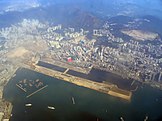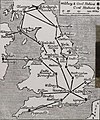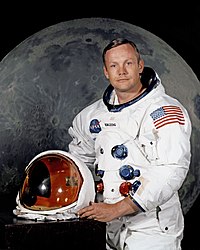Portal:Aviation
| Main page | Categories & Main topics |
|
Tasks and Projects |
The Aviation Portal

Aviation includes the activities surrounding mechanical flight and the aircraft industry. Aircraft includes fixed-wing and rotary-wing types, morphable wings, wing-less lifting bodies, as well as lighter-than-air aircraft such as hot air balloons and airships.
Aviation began in the 18th century with the development of the hot air balloon, an apparatus capable of atmospheric displacement through buoyancy. Some of the most significant advancements in aviation technology came with the controlled gliding flying of Otto Lilienthal in 1896; then a large step in significance came with the construction of the first powered airplane by the Wright brothers in the early 1900s. Since that time, aviation has been technologically revolutionized by the introduction of the jet which permitted a major form of transport throughout the world. (Full article...)
Selected article
With numerous skyscrapers and mountains located to the north and its only runway jutting out into Victoria Harbour, landings at the airport were dramatic to experience and technically demanding for pilots. The History Channel program Most Extreme Airports ranked it as the 6th most dangerous airport in the world.
The airport was home to Hong Kong's international carrier Cathay Pacific, as well as regional carrier Dragonair, freight airline Air Hong Kong and Hong Kong Airways. The airport was also home to the former RAF Kai Tak. (Full article...)
Selected image
Did you know
...that Astro Flight, Incorporated of Marina del Rey, California created the world's first practical electric-powered radio controlled model airplane and the world's first full-scale solar-powered airplane? ...that Theo Osterkamp was the first German reconnaissance pilot to fly a land-based aircraft to England during World War I?
- ... that the crash of an Australian National Airways Stinson in 1945 was believed by investigators to be the first in-flight structural failure attributable to metal fatigue?
General images -
In the news
- May 29: Austrian Airlines cancels Moscow-bound flight after Russia refuses a reroute outside Belarusian airspace
- August 8: Passenger flight crashes upon landing at Calicut airport in India
- June 4: Power firm helicopter strikes cables, crashes near Fairfield, California
- January 29: Former basketball player Kobe Bryant dies in helicopter crash, aged 41
- January 13: Iran admits downing Ukrainian jet, cites 'human error'
- January 10: Fire erupts in parking structure at Sola Airport, Norway
- October 27: US announces restrictions on flying to Cuba
- October 3: World War II era plane crashes in Connecticut, US, killing at least seven
- September 10: Nevada prop plane crash near Las Vegas leaves two dead, three injured
- August 6: French inventor Franky Zapata successfully crosses English Channel on jet-powered hoverboard
Related portals
Associated Wikimedia
The following Wikimedia Foundation sister projects provide more on this subject:
-
Commons
Free media repository -
Wikibooks
Free textbooks and manuals -
Wikidata
Free knowledge base -
Wikinews
Free-content news -
Wikiquote
Collection of quotations -
Wikisource
Free-content library -
Wikiversity
Free learning tools -
Wikivoyage
Free travel guide -
Wiktionary
Dictionary and thesaurus
Selected biography
Before becoming an astronaut, Armstrong was in the United States Navy and saw action in the Korean War. After the war, he served as a test pilot at the National Advisory Committee for Aeronautics (NACA) High-Speed Flight Station, now known as the Dryden Flight Research Center, where he flew over 900 flights in a variety of aircraft. As a research pilot, Armstrong served as project pilot on the F-100 Super Sabre A and C aircraft, F-101 Voodoo, and the Lockheed F-104A Starfighter. He also flew the Bell X-1B, Bell X-5, North American X-15, F-105 Thunderchief, F-106 Delta Dart, B-47 Stratojet, KC-135 Stratotanker and Paresev. He graduated from Purdue University.
Selected Aircraft
The B-36 was the only American aircraft with the range and payload to carry such bombs from airfields on American soil to targets in the USSR, as storing nuclear weapons in foreign countries was diplomatically delicate. The nuclear deterrent the B-36 afforded may have kept the Soviet Army from fighting alongside the North Korean and Chinese armies during the Korean War. Convair touted the B-36 as an "aluminum overcast," a "long rifle" to give SAC a global reach. When General Curtis LeMay headed SAC (1949-57) and turned it into an effective nuclear delivery force, the B-36 formed the heart of his command. Its maximum payload was more than four times that of the B-29, even exceeding that of the B-52.
- Span: 230 ft 0 in (70.10 m)
- Length: 162 ft 1 in (49.40 m)
- Height: 46 ft 9 in (14.25 m)
- Engines: 6× Pratt & Whitney R-4360-53 "Wasp Major" radials, 3,800 hp (2,500 kW) each
- Cruising Speed: 230 mph (200 kn, 380 km/h) with jets off
- Range: 6,795 mi (5,905 nmi, 10,945 km) with 10,000 lb (4,535 kg) payload
- First Flight: 8 August 1946
Today in Aviation
- 2009 – A de Havilland Canada DHC-8-200 being operated on behalf of United States Africa Command was substantially damaged when the undercarriage collapsed and the starboard wing was ripped off in an emergency landing at Tarakigné, Mali.
- 2009 – Compagnie Africaine d'Aviation Flight 3711, operated by McDonnell Douglas MD-82 9Q-CAB overran the runway on landing at Goma International Airport, suffering substantial damage. The overrun area was contaminated by solidified lava.
- 1999 – Launched: Shenzhou 1, China's first spacecraft.
- 1997 – Launch: Space Shuttle Columbia STS-87 at 14:46 EST. Mission highlights: Microgravity experiments, 2 EVAs, SPARTAN.
- 1996 – Launch: Space Shuttle Columbia STS-80 at 2:55:47 p.m EST. Mission highlights: Wake Shield Facility; ASTRO-SPAS.
- 1996 – United Express Flight 5925, a Beechcraft 1900, collides with a privately-owned Beechcraft King Air at Quincy Regional Airport, Illinois; killing all 14 on board both aircraft.
- 1977 – TAP Portugal Flight 425, a Boeing 727, overruns the runway at Madeira Airport and plunges over a steep bank, bursting into flames and killing 131 of the 164 people on board.
- 1975 – First flight of the AmEagle American Eaglet
- 1975 – First of three Boeing-Vertol YUH-61 helicopters completed, 73-21656, crashes and is moderately damaged during testing, but two company pilots escape injury. Cause is found to be failure of tail rotor drive shaft after the main rotor oversped during an auto-rotational recovery. Airframe is repaired. Now preserved at the Army Aviation Museum, Fort Rucker, Alabama. Type loses competition to Sikorsky UH-60 and airframes four and five are not completed.
- 1969 – Mohawk Airlines Flight 411, a Fairchild 227, crashes near Glens Falls, New York, killing all 14 people on board.
- 1969 – Apollo 12 lands on the Moon, allowing Charles "Pete" Conrad and Alan L. Bean to become the third and fourth humans to walk on its surface.
- 1960 – First flight of the Hawker Siddeley P.1127
- 1958 – Introduction: Fokker F27 Friendships were delivered to Aer Lingus.
- 1954 – A North American B-25 Mitchell on an "unauthorized flight" from Keesler Air Force Base crashed 400 yd (370 m) off shore into the Mississippi Sound, exploding near the Biloxi lighthouse.
- 1952 – A North American F-86D Sabre fighter sets a new world speed record of 698.505 mph.
- 1951 – A Boeing B-47B-5-BW Stratojet, 50-006, crashes shortly after an afternoon take-off at Edwards Air Force Base, California, killing three crew. The bomber comes down a quarter mile W of the runway and explodes. Officials at the base said the bomber was beginning a routine test flight. Killed are Captain Joseph E. Wolfe, Jr., the pilot, Chattanooga, Tennessee; Major Robert A. Mortland, 30, co-pilot, of Clarion, Pennsylvania, and Sergeant Christy N. Spiro, 32, of Worcester, Massachusetts.
- 1948 – Fairey Aviation Company of Canada was established and took over the facilities of the Clark-Ruse Aircraft Co. at Dartmouth, Nova Scotia.
- 1947 – Only accident of the Martin XB-48 test programme occurs when pilot E. R. "Dutch" Gelvin tries to abort takeoff in first prototype, 45-59585, from NAS Patuxent River, Maryland, when fire warning light comes on as engines reach full power. He retards throttle and applies brakes but bomber does not slow. As he runs out of runway and as the brake pressure bleeds off, he has a choice of running into the Chesapeake Bay or heading for the mudflats - he opts for the latter. He turns off the runway, tries to retract the undercarriage, runs across a ditch, a road, another ditch, left outrigger gear collapses and jet slides to stop leaning to port, just 50 feet short of a Navy doctor's home. Damage is minimal, limited to gear doors, outrigger, and flaps. Cause was the emergency fuel system, designed to maintain engine power at 94 percent, regardless of throttle position. This will be eliminated in second prototype.
- 1946 – Trans Canada Airlines received the first of five North Stars on loan from the RCAF.
- 1944 – U. S. Navy Task Force 38 carrier aircraft strike Luzon, destroying more than 100 Japanese aircraft in exchange for the loss of 13 U. S. planes in combat.
- 1941 – North American P-64, 41-19086, assigned to the 66th Air Base Squadron, Luke Field, Arizona, crashes and burns 20 miles NW of Luke Field after a stall/spin, killing pilot Charles C. Ball. Mölders, pilot Oberleutnant Kolbe and flight engineer Oberfeldwebel Hobbie were killed. Major Dr. Wenzel and radio operator Oberfeldwebel Tenz survived the crash landing. Dr. Wenzel sustained a broken arm and leg as well as a concussion, and Tenz a broken ankle. Mölders' fatal injuries included a broken back and a crushed ribcage. Accident investigators then and since have speculated whether Mölders would have survived the crash if he had used his seat belt. In his memory, on 20 December 1941, JG 51 was bestowed the honor name "Mölders".
- 1940 – The formation of the Air Cadet League of Canada formed to train 12-18 year-olds for future enlistment in the RCAF.
- 1938 – RCAF became directly responsible to the Minister of National Defence instead of the Chief of the General Staff, and achieved equal status with the RCN and Canadian Army.
- 1938 – Construction begins on a new airport serving the nation’s capital, Washington, D. C. built in nearby Virginia, and this airport will become Ronald Reagan National Airport.
- 1936 – (19-22) Curious to see the reaction of a civilian population to an attempt to systematically destroy its city by bombing, officers of the German Condor Legion supporting Francisco Franco's desire to bomb Madrid into surrendering oversee a bombing campaign by German Junkers Ju 52 and Italian Savoia-Marchetti SM.81 aircraft that kills 150 people in the city. It is the heaviest bombing ever carried out against a city up to that time.
- 1932 – First flight of the ANF Les Mureaux 170
- 1932 – A national monument to the Wright Brothers is unveiled at Kitty Hawk, North Carolina.
- 1931 – Introduced: Sikorsky S-40 with Pan American
- 1922 – Malert (Magyar Legiforgalmi) is formed, a fore-runner of MALÉV Hungarian Airlines.
- 1921 – Flying a Curtiss CR-2, Bert Acosta sets a new world speed record of 197.8 mph (318.32 km/hr)
- 1916 – Ruth Law sets a new distance record for cross-country flight by flying 590 miles (950 km) non-stop from Chicago to New York State. She flies on to New York City the next day.
- 1915 – First combat search and rescue: Richard Bell-Davies rescued a comrade who had been shot down in Bulgaria.
- 1912 – Italy's colonial air force is established as the Servizio d'Aviazione Coloniale.
- 1903 – After inventing and patenting the V8 engine the year before, Léon Y. K. Levavasseur demonstrates his Antoinette engine, designed as a lightweight powerplant specifically for aircraft.
References
- Shortcuts to this page: Portal:Airplanes • P:AVIA























































